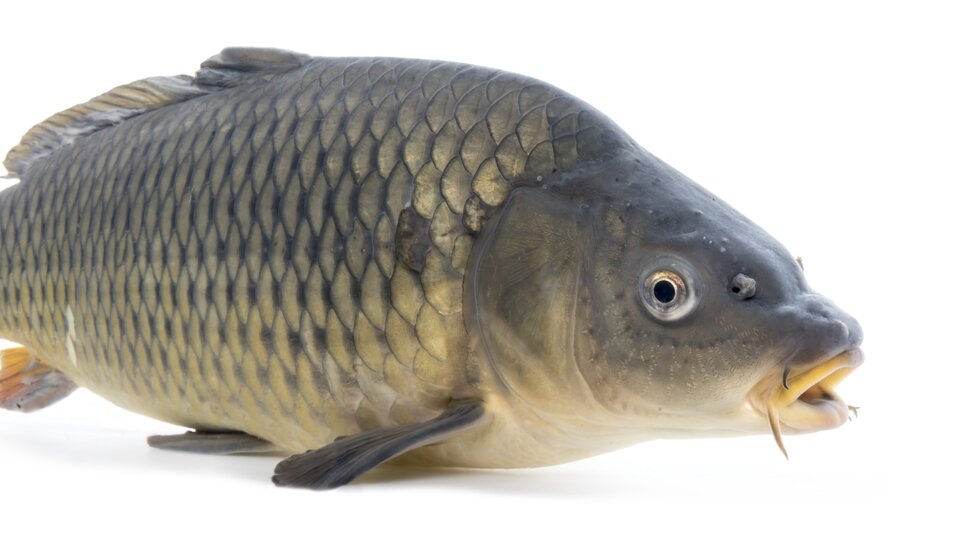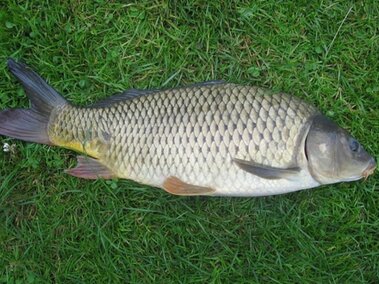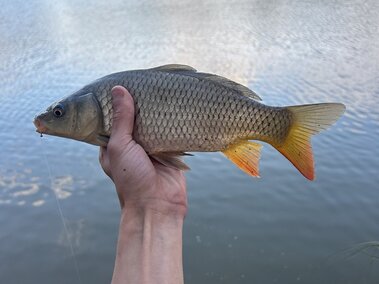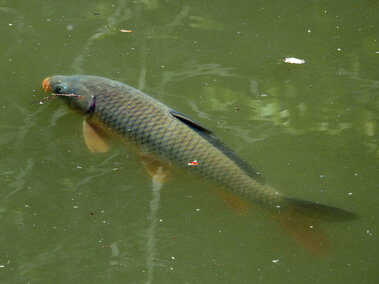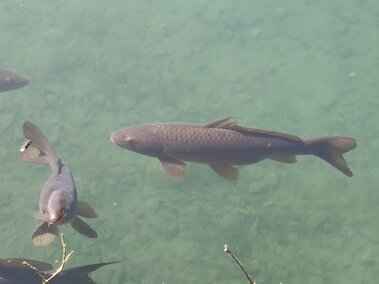Credit: Sam Stukel /USFWS, Public Domain
General Information
Species Name: Cyprinus carpio
Also Known As: European carp, German carp, mirror carp, leather carp
Family: Cyprinidae (Minnow)
Life Span: Up to 50 years
Life Cycle: Spawning begins in late April and continues into June with females laying between 100,000 and 500,000 eggs.
Origin: Europe and Asia
Injurious: No.
Category 3: Established Aquatic Invasive Species
Why Are They Invasive?
Introduction of the common carp causes dramatic ecological disruptions at both the community and ecosystem level. The common carp is omnivorous, feeding on benthic aquatic organisms such as insect larvae, worms, mollusks and zooplankton as well as the stalks, seeds, and leaves of aquatic plants. This foraging behavior increases the turbidity of the water, which releases phosphorous and increases algae growth. This foraging also prevents the growth of native aquatic plants and ultimately has a negative impact on water quality.
What Do They Look Like?
Its body is heavy and stout, averaging 25-55 cm (10-22 in) in length and weighing 1-10 pounds, although some can reach up to 80 pounds! Color varies from bronze, brassy, or yellow with large scales usually outlined in black. The head is short with a rounded snout, a toothless sucker-like mouth, and two pairs of barbels on each side of the upper jaw. Varieties of common carp include mirror carp, leather carp, and koi, which is popular in small ponds and water gardens.
Photos
Where Do They Live?
The common carp is tolerant of cold winter periods and low oxygen concentrations. It is most often found in manmade impoundments, lakes, ponds, and turbid sluggish streams receiving sewage or agricultural runoff, and is less abundant in clear waters or streams with a high gradient. It also inhabits brackish-water estuaries, backwaters, bays, and shallow water during spring spawning.
How Do They Spread?
It’s unclear exactly when the species was introduced into the United States, but most sources suggest that it was introduced in the 1800s as a food and game fish. By 1885, the U.S. Fish Commission was actively stocking lakes and rivers throughout the country with common carp, and it is now prevalent throughout the entire United States. Common carp are migratory, and once introduced will spread naturally through waterway connections to other bodies of water to spawn. Young common carp can resemble baitfish, so anglers present another vector of spread by using them as bait.
How Do I Control Them?
Management of invasive fish involving either mechanical removal or application of chemicals to public waters requires a permit. Contact the Contact the Nebraska Game and Parks Commission for more information.
CLEAN your watercraft, trailer, angling gear and other equipment. Remove all aquatic vegetation and animal species from your equipment.
DRAIN your watercraft at the ramp by removing the boat plug and draining all live wells and ballast tanks.
DRY your watercraft, trailer and other equipment for at least 7 days before visiting another waterbody.
DON'T DUMP BAIT. Dispose of bait by emptying bait buckets on dry land, away from waterbodies or in a trash receptacle. Moving a live organism from one waterbody to another is illegal, even if you are planning to use the organism as bait.
DON'T LET IT LOOSE. Do not release or transport exotic or non-native fish species to new ecosystems. It is unlawful to release any aquatic species into a waterbody other than the one from which it was harvested. Doing so can promote the spread of AIS.
What Should I Do If I See Them in Nebraska?
If you see common carp in Nebraska, you should report them to the Nebraska Game and Parks Commission's Aquatic Invasive Species (AIS) Program using their AIS Report Form. For guidance on what information to include in your report, check out our reporting tips.
References and More Information
Center for Invasive Species and Ecosystem Health
Minnesota Department of Natural Resources
